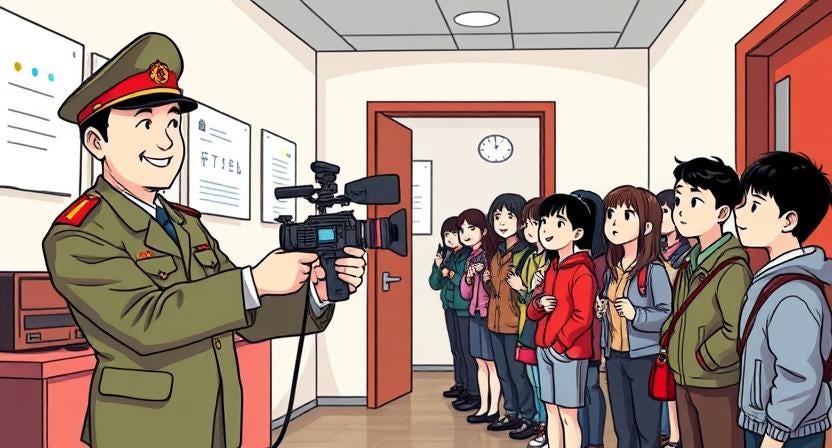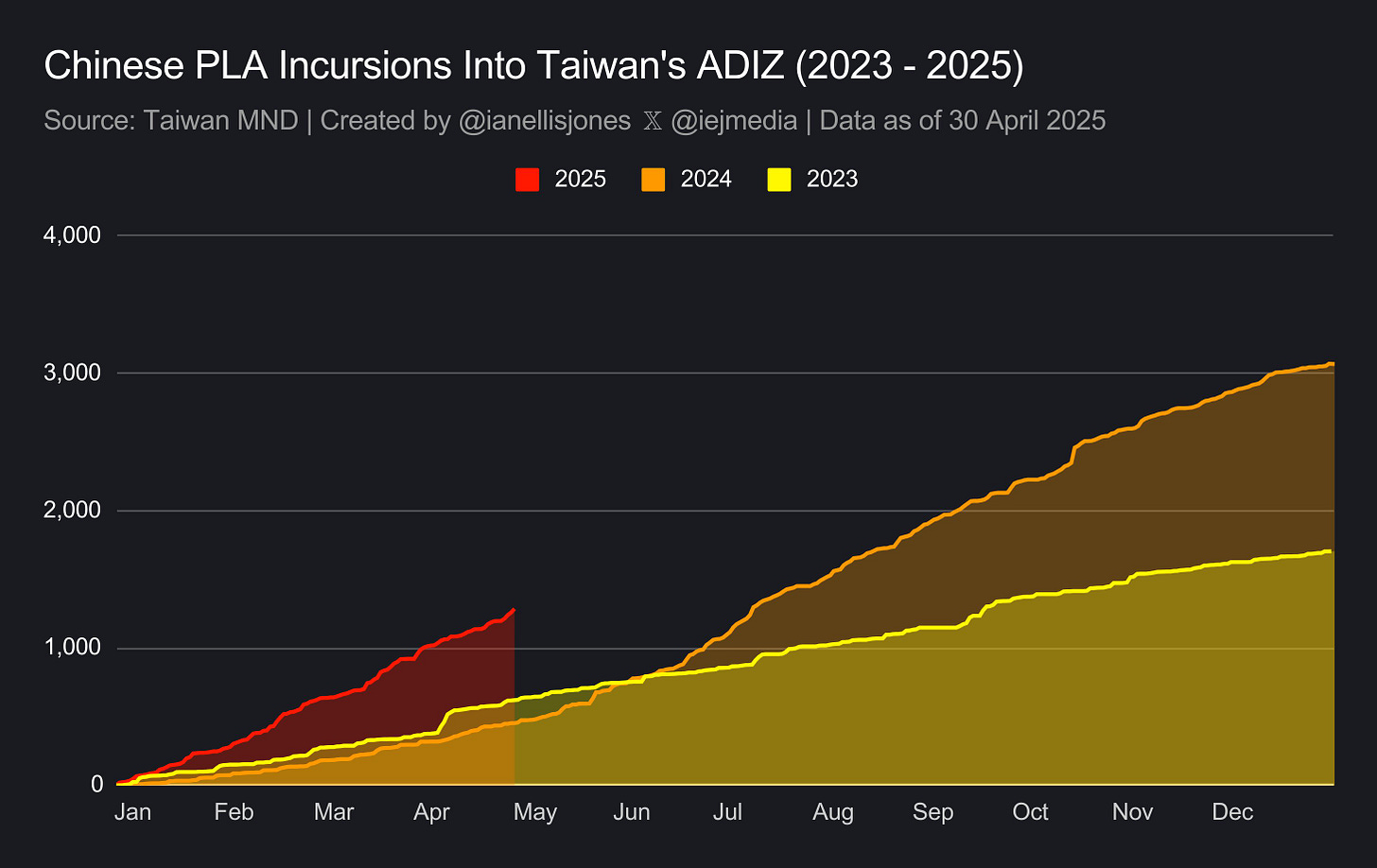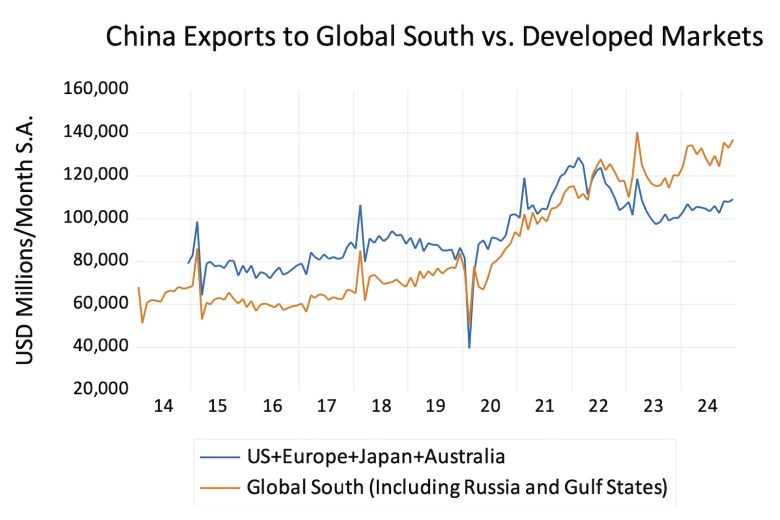China's army launches media hiring spree
The PLA is boosting its news department: the latest step in readying for a Taiwan invasion? Also, how Trump's tariff war may actually be helping China...
The People’s Liberation Army is embarking on an unpreceded hiring spree of young media recruits, amid a military build up in the South China Sea.
To illustrate the sheer scale, China Daily, the country’s largest English language paper is currently recruiting for four positions. How many are the PLA’s News Center currently seeking? 46.
The numbers are even more stark when considering that as recently as 2018, the PLA reduced staff numbers at its flagship newspaper PLA Daily from 300 — to less than 60.
So what is going on…?
The roles
The listings make for interesting reading. Editors. Artists. Cameramen. Presenters. Musicians. Proofreaders. This is a full capacity upgrade.
There’s a hard cap on ages at 35 years old. (40 if you have military experience).
Personnel are required to “support the leadership of the Communist Party of China, love the motherland, love the military cause”. Phrases which have become omnipresent across ads for media roles in recent years, since Xi’s 2016 decree the media should show “absolute loyalty”. Though, how these are essential qualities for the handyman position — also being advertised — is beyond me.
Restrictions go even further in some cases. One post for “Document Management” explicitly states “men are preferred”. Duties for this clerk role include “uploading and issuing work tasks”, “admin” and “archiving”, apparently all deemed far beyond a female’s capability. Needless to say, this discrimination — though widespread in the Mainland — is completely illegal under Chinese law, a fact the Ministry of Human Resources felt the need to reiterate in 2019.
Salaries for the PLA roles are only listed as “negotiable”, but for comparison, the China News Service International Communications Group in Beijing is currently hiring nine very similar positions at 5,000-8,000 RMB per month.
While this may be below what young Chinese can earn in private industries, it also still far outstrips general graduate wages across China.
Applications, I hear, have only increased recently thanks to rising youth unemployment, and several graduate-heavy industries destroyed, seemingly over night. Chinese refer to these vaunted state positions as “iron rice bowls”, aka a job for life.
So what will they do?
Current PLA output is spread far and wide in China. TV adverts. Subway screens. Posters in banks. Just last month, the PLA Navy opened its first ever international social media account. Always on trend, it did so on X — right as users flee the platform.
PLA content quality fluctuates.
Videos range from the lusciously shot, all-action thumping Top Gun-style videos of military drills, to those which are… less so. Behold this animation the PLA released in May 2024 of missiles raining down on Taiwan — a proposition that would be terrifying if not for the Windows 95-era graphics. Incidentally, the PLA’s News Center are recruiting one 3D, and four 2D animation artists. Much needed.
Last year, the PLA launched a new AI anchor. Named “Mulan”, her impact has been mixed. “I still want to see real people,” said one comment.
The PLA News Center staffing up could also be a reaction to the CPC’s own actions.
On March 1, the Party rolled out new regulations greatly restricting the online publication of military information. The Party said it is launching the measures to stop “the spread of false military information” and “the leakage of military secrets”. Ironically, the hardest hit has been some of the Party’s own most loyal supporters: the band of patriotic fanboys who regularly post snippets and pictures of military hardware to millions of views on social media. More state hands could be a way to sate that audience’s thirst with officially sanctioned content.
Of course. There could also be another reason.
The Taiwan in the room
“No one can prevent the historical trend toward the unification of the motherland,” said Xi Jinping in his New Year’s speech on Jan 1.
Drills around the island have progressively ramped up in recent years. Air incursions — particularly those where the PLA fly jet bombers directly at the island, only to turn around just past the halfway point — have increased exponentially in both number and size. Already this year the PLA has made as many incursions as the whole of 2023. Each requires Taiwanese air force to scramble jets, an effort they call “exhausting”.
Another recent development has been to fly “weather” balloons over Taiwanese airspace. As the US discovered, when they shot one down over South Carolina waters in 2023, these huge crafts can hold communications monitoring equipment able to tap into networks below.
While at sea, critical underwater cables are increasingly “accidentally” cut by Chinese fishing boats. And the navy practices ways to blockade Taiwanese ports.
All in all, the direction of travel is emphatic, unerring, and deeply, deeply worrying.
This year, the PLA didn’t even bother codenaming its mass drills — something multiple Chinese state outlets were only happy to point out. China Daily abandoned subtext altogether, saying the quiet part out loud. “This reflects a new normal,” it said in a breathless video.

More disconcertingly, there has been an active effort to dehumanise Taiwanese people, and in particular, their leaders. In April, the PLA released a series of cartoons. One depicted President Lai Ching-te as a bug being held over a fire.
During its military drills, PRC state media also propagated disinformation campaigns that President "Tsai Ing-Wen flees”. Equally, when Taiwan staged its own drills, state media claimed these were practice runs for the Taiwanese leadership to escape.
This propaganda combination of “othering” supposed Chinese brethren and delegitimizing democratically elected politicians has been seen before. China used it to good effect during its crackdown on Hong Kong. If a Taiwan invasion were forthcoming, one would expect a similar campaign prior, to soften minds.
Timeline
Many have predicted China is looking to “re-unite the country” before 2027, the centenary of the PLA’s founding. While the state has give no exact timeline, the CPC has dropped hints.
“The PLA will resolutely implement the Party's overall policy for resolving the Taiwan question in the new era”, said Senior Colonel Wu Qian in April. For those uninitiated, “new era,” is often code for Xi’s tenure.
It is certain that mass armament is underway. There are now around 90 operational Chinese airfields within strike range of Taiwan. In Chinese docks, landing barges are being welded together. Not to mention the huge new 1500-acre command center under construction in Beijing — ten times larger than the Pentagon.
Perhaps more crucially, there is a biological ticking clock. While Xi is ordained President for life, the pudgy ex-smoker is currently 71, and frequently goes missing for weeks at a time. Each occasion, rumours of his health abound. He is prone to rapid weight loss, and gain. His hair often whitens and darkens overnight, notes netizens. He is on limited time.
Xi only needs look at his contemporaries. The sad decline of previous President Hu Jintao, said to be suffering from mental decline, possibly dementia or Alzheimer’s, most public when he was removed from the Two Sessions. Or the sudden heart attack of Xi’s long-time Premier, Li Keqiang in 2023, which took him aged 68. It must linger in the mind.
Then there are vaunted pet projects like the Belt & Road; or China becoming the world’s largest economy; or efforts to reverse China’s dwindling population; or even the more spurious, like China becoming a footballing superpower — all launched to great patriotic fanfare since 2012, and all have withered on Xi’s watch. Xi knows capturing Taiwan would lift his tenure above that of presidential footnotes like Hu, and Jiang Zemin to prominently cement his place in the annals of China’s long history.
The problem is taking Taiwan would be an incredible gamble, one near-certain to turn much of the world hard against China.
At best, and China’s preferred plan, is for a quick knock-out blow that Russia attempted — but bungled — in Ukraine. To smash enough local infrastructure, military sites, governmental hierarchy, and local citizen will before the world can muster reaction to a remote mountainous island in China’s backyard. A quick fait accompli that western powers would be forced to accept.
The worst scenario is a domino effect of protracted cataclysmic destruction.
Either way, China would face economic pariah status from much of the West, and biting sanctions. However, on this, China has long been preparing. Too little was made of the Party’s “Dual circulation” economic policy, launched in 2020. Perhaps it’s the dull name, but the aim is deceptively simple: boost domestic consumption, and develop self-sustainability. Pick an industry, and recent gains are stark. Computer chips, rare earth metals, grain, pork, water, energy — all have seen big upticks in the domestic production, and China look to wean itself off imports.
Many analysts have viewed this wholly via economic terms: that Beijing is trying to fire its sputtering economy post-Covid. Well. Here’s another reading: is this prudent governance. Or is Beijing preparing to hunker down?
In many ways, Trump’s tariff war, too, is proving an excellent soft run for China. The great irony is that by seeking to contain China aggressively now, Trump may unwittingly be helping build its defenses in the future.
US-China trade, though by far the world’s biggest trading partnership, represents just three percent of overall Chinese GDP — far less than the 5 percent the Chinese economy grew by last year. It’s pain. But it’s shruggable.
In 2022, China achieved a great paradigm shift, as it began to export more to the Global South than the western world for the first time. This is a deliberate rebalancing.
Staunch allies a la Russia, and their “no limits partnership” aren’t the only requirement. Just as powerful would be for nations to shrug with indifference.
A few years ago, as the world sneezed with Covid, and public opinion of Beijing plunged record depths, that ambition seemed impossible. But since, thanks to a mixture of diplomacy, trade, bribery and steady narrative, China has made great headway — particularly among small geostrategically important nations in the Pacific; bankrupted, forgotten Global South nations; and political outcasts, like Hungary, Iran, or Afghanistan.
Under Trump 2.0, and the tariff war, as more and more nations feel the wrath of Trump’s roughshod, bullying realpolitik, that furrow is getting even softer to plough.
Beijing will be watching at home too. Of its people’s ability to swallow economic pain, or “eat bitterness” as Xi famously described youth hardship. Of citizen’s willingness to rally behind the flag. Can they be activated, triggered to patriotism? Especially if propaganda outlets are upgraded, honed?
On all fronts, Beijing is finding contentment.
Watch the watchers
And so we come full circle to this PLA media recruitment push.
China, it must be said, is not the only one building journalistic capacity. Western newsrooms are also sending correspondents to embed in Taiwan (full disclosure, I recently interviewed for one). Across the board, I’m hearing a gentle scaling up is underway.
There’s talk that one China bureau head, at a large international media took the role in the last few years primarily as they foresaw the Taiwanese invasion being soon, and it being the pinnacle of their career. A “when bombs fell on Taipei: I was there”. Book deals. Promotions. Honours. In post, staff say all the chief wants to hear is of how war is coming, and regularly spikes other content. Word is they’re becoming increasingly frustrated, kicking their heels, as their sick bet fails to come true.
Personally, I have absolutely no clue whether the PLA will cross the strait. China still walks the line where all its actions could be dismissed as mere prudent governance, a country coming of age — albeit with a 75 year chip on its shoulder.
Equally, nearly every single observable measure: rhetoric, military, economic and yes — propaganda capacity — says invasion is coming.
When? How? I’m not sure.
But a tip. Want to know what will happen in the news tomorrow? Watch those who’ll write it.










I know the PLA is aggressively trying to recruit technical personnel. My guess is it’s still struggling to staff the CSF, ASF, and ISF. Recruitment is targeting top-tier STEM universities like Tsinghua and BIT, while new pay scales and joint civilian-military training aim to retain talent. But particularly with S&T, high turnover and competition from the private sector surely undercut recruitment goals. I write more about PLA C4ISR on my Substack, if interested. https://ordersandobservations.substack.com